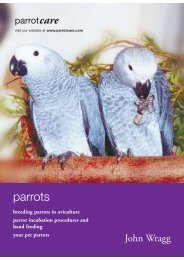incubation procedures and hand feeding - Parrotcare
incubation procedures and hand feeding - Parrotcare
incubation procedures and hand feeding - Parrotcare
Create successful ePaper yourself
Turn your PDF publications into a flip-book with our unique Google optimized e-Paper software.
parrotcare visit our website at www.parrotcare.com<br />
mortality rates<br />
It would be true to say that mortality rates amongst<br />
chicks hatched from the egg should not exceed one or<br />
two in a hundred. If deaths in the h<strong>and</strong> rearing room<br />
exceed this number then they must be regarded as<br />
suspicious. Very few parrot babies die suddenly in the<br />
h<strong>and</strong> rearing room unless by accidents caused by<br />
choking on formula or accidental death by physical<br />
injury i.e. dropping the chick. Prior to any chick’s death,<br />
there is a period when it is possible to identify problems<br />
are occurring <strong>and</strong> therefore urgent action is needed to<br />
rectify whatever the problem is. The main areas to<br />
check are cleanliness of spoons, cups, brooders <strong>and</strong><br />
chick containers, humidity <strong>and</strong> the level of bacteria that<br />
may build up in water used in the brooder, the<br />
temperature <strong>and</strong> viscosity of the h<strong>and</strong> rearing formula,<br />
temperatures in the brooder which should relate to the<br />
chick’s age.<br />
Chick colouration is a direct indicator of health.<br />
Healthy chicks should have a pinky look about<br />
them <strong>and</strong> any signs of pallor could be regarded as<br />
unacceptable <strong>and</strong> a sign of ill health. Weight gain is also<br />
important. A parrot chick should increase in weight by<br />
approx. 20% over day over the first 2-3 weeks.<br />
Whenever brooders, hatchers are not being used they<br />
must be immediately disinfected for any new chicks to<br />
enter. It is fatal to continue to use a brooder throughout<br />
the breeding season without disinfecting regularly.<br />
Commercial products are available which can reduce the<br />
level of bacteria which may be prevalent in water used<br />
for brooders in connection with air humidity. Remember<br />
if you are to disinfect the h<strong>and</strong> rearing room <strong>and</strong> its<br />
contents, you must be extremely careful that any<br />
chemicals, pesticides or disinfectants do not cause the<br />
death of any chicks. While performing any disinfecting<br />
tasks of hatchers <strong>and</strong> brooders it is often wise to remove<br />
them from the h<strong>and</strong> rearing room. If the h<strong>and</strong> rearing<br />
room is to be disinfected then a good circulation of air is<br />
required. A large selection of commercially available<br />
disinfectants are specially manufactured for this task.<br />
chick identification<br />
In most cases, where limited numbers of parrot chicks<br />
are h<strong>and</strong> reared, it will be unnecessary<br />
to identify chicks, as this<br />
information will be readily contained<br />
in the breeder’s head. In larger<br />
more commercial operations, it<br />
will be necessary to identify chicks<br />
for blood line. This can be done<br />
by felt pen in different colours <strong>and</strong><br />
the use of plastic leg rings, which<br />
are exp<strong>and</strong>able throughout the life<br />
of the chick. Once independent,<br />
these leg rings can be removed.<br />
Parrot chicks can be close rung at<br />
between 2/3 weeks <strong>and</strong> these<br />
rings can be obtained from the<br />
Parrot Society or commercial<br />
organisations. Parrots because of the variety in size have<br />
numerous leg rings available. It is obviously critical that<br />
only the appropriate leg ring should be placed on the<br />
bird. If an incorrect steel leg ring were to be placed on a<br />
chick then at a later stage in life when the leg grows it<br />
could cause to stop the circulation to the foot <strong>and</strong> therefore<br />
require removal. The following is the UK Parrot<br />
Society recommended size for various parrots.<br />
Variety of Bird Close ring size<br />
Grass parrots L/M<br />
Parakeets<br />
Love birds<br />
Kakariki<br />
Many coloured<br />
Red Rump<br />
Stanley<br />
Rosella<br />
Cockateels N<br />
Larger Rosellas<br />
Pileated<br />
Smaller Conures<br />
Smaller Lorys<br />
Port Lincolns P<br />
POWs<br />
Barrab<strong>and</strong>s<br />
Cloncurries<br />
Pennants<br />
Dusky <strong>and</strong> Perfect Lorrikeets<br />
Slatey Headed Conures<br />
Sun<br />
Red Bellied<br />
N<strong>and</strong>ay<br />
Jendaya<br />
Blue Throated Conures<br />
Quakers<br />
Crimson Wings R<br />
Chattering Lorys<br />
Mayers<br />
Plum Heads<br />
Red Throated Conures<br />
Red Bellied<br />
Rock Pebblers<br />
Senegals



